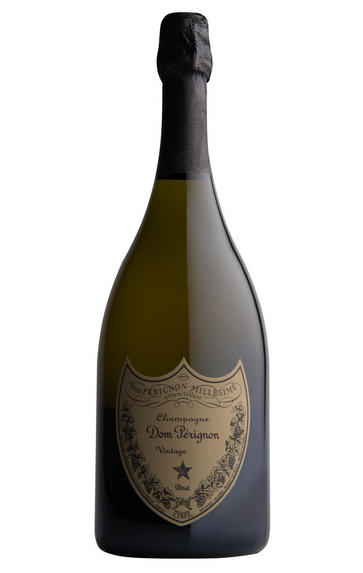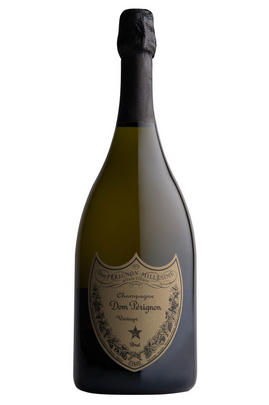
2005 Champagne Dom Pérignon, Brut

Critics reviews
Antonio Galloni - Vinous Media.
Stephan Reinhardt - 30/06/2016
They had just taken delivery of few hundred cases of the stuff, and even the owner, Fabio Cattaneo, hadn’t tasted it. I believe that the 2005 DP is the best since 2002, which remains the best recent vintage and is probably only eclipsed by the amazing 100-point 1996. The 2005 is a full-bodied DP with so much richness and loads of ripe fruit such as pineapple and papaya. It has a wonderful, creamy texture and a long and intense finish. It’s a Champagne that fully satisfies but at the same time challenges you with its strength, depth and persistence on the palate. I rate it 97 points.
James Suckling - jamessuckling.com - June 5th 2015
About this WINE

Dom Perignon
Dom Pérignon was the 17th century Benedictine monk who has gone down in history as the person who "invented" Champagne. His name was originally registered by Eugène Mercier. He sold the brand name to Moët & Chandon, which used it as the name for its prestige cuvée, which was first released in 1937.
A rigorous selection process in both the vineyard and winery ensures that only the best grapes go into Dom Pérignon champagne. Chardonnay and Pinot Noir are used in roughly equal proportions without one variety dominating the other.
In its youth, Dom Pérignon shows incredibly smooth, creamy fruit with perfect balance and weight. As it ages, it takes on wonderfully toasty aromas and a finesse equalled by very few of the other Grandes Marques.
Since 2014 Dom Pérignon has no longer been using the term oenothèque for its late-release Champagnes, but the word Plenitude. This style represents Dom Pérignon champagne that is left in contact with its lees and does not evolve in a linear fashion, but ages in a series of stages, producing “windows of opportunity, or plenitudes” when the Champagne can be disgorged and released to bring consumers a different expression of the same vintage.
There are three plenitudes in the life of a given vintage: the first plenitude spans between seven to eight years after the vintage, which is when Dom Pérignon Vintage is released, while the second one arrives between 12 and 15 years – which was previously the first oenothèque release, but from now will be branded as P2. The third window comes after around 30 years, when the Champagne has spent more than 20 years on its lees, which will now be termed as P3.

Brut Champagne
Brut denotes a dry style of Champagne (less than 15 grams per litre). Most Champagne is non-vintage, produced from a blend from different years. The non-vintage blend is always based predominately on wines made from the current harvest, enriched with aged wines (their proportion and age varies by brand) from earlier harvests, which impart an additional level of complexity to the end wine. Champagnes from a single vintage are labelled with the year reference and with the description Millésimé.
Non-vintage Champagnes can improve with short-term ageing (typically two to three years), while vintages can develop over much longer periods (five to 30 years). The most exquisite and often top-priced expression of a house’s style is referred to as Prestige Cuvée. Famous examples include Louis Roederer's Cristal, Moët & Chandon's Dom Pérignon, and Pol Roger's Cuvée Sir Winston Churchill.
Recommended Producers : Krug, Billecart Salmon, Pol Roger, Bollinger, Salon, Gosset, Pierre Péters, Ruinart

Champagne blend
Which grapes are included in the blend, and their proportion, is one of the key factors determining the style of most Champagnes. Three grapes are used - Pinot Noir, Chardonnay and Pinot Meunier.
26% of vineyards in Champagne are planted with Chardonnay and it performs best on the Côtes des Blancs and on the chalk slopes south of Epernay. It is relatively simple to grow, although it buds early and thus is susceptible to spring frosts. It produces lighter, fresher wines than those from Burgundy and gives finesse, fruit and elegance to the final blend. It is the sole grape in Blancs de Blancs, which are some of the richest long-lived Champagnes produced.
Pinot Noir accounts for nearly 40% of the plantings in Champagne and lies at the heart of most blends - it gives Champagne its body, structure, strength and grip. It is planted across Champagne and particularly so in the southern Aube district.
The final component is Pinot Meunier and this constitutes nearly 35% of the plantings. Its durability and resistance to spring frosts make the Marne Valley, a notorious frost pocket, its natural home. It ripens well in poor years and produces a soft, fruity style of wine that is ideal for blending with the more assertive flavours of Pinot Noir. Producers allege that Pinot Meunier lacks ageing potential, but this does not deter Krug from including around 15% of it in their final blends.


Buying options
Add to wishlist
Description
A fourth consecutive vintage release might hint at an over-abundance of Moët’s flagship brand but the 2005 fits in neatly with the three previous contrasting years and no doubt those still to come in what is proving to be a stellar decade for fine Vintage Champagnes. The 2005 has a high proportion of Chardonnay yet a firm core of Pinot Noir provides the wine with backbone that will see it develop and improve for many years. There’s a lingering, yellow-fruit quality here that has real appeal. A small vintage, and a challenging one, this deserves consideration and is a credit to Chef de Cave Richard Geoffroy.
Tom Cave - Cellar Plan Manager
My immediate thought was “very DP” – lemon, yellow stone fruit and red berries, with an amaretti biscuit touch on the finish. At around 62% Chardonnay, this is the most white grape orientated Dom Pérignon for some time but it is the Pinot Noir fruit profile that shows at the moment. Very taut and precise, with a floral touch on palate and lots of citrus. Very drinkable! There is an impressive length to the finish. Kudos to Richard Geoffroy and his team for creating a beauty in this warm and quite difficult vintage. Give this a few years in the cellar to fill out.
Fergus Stewart, Private Account Manager
wine at a glance
Delivery and quality guarantee